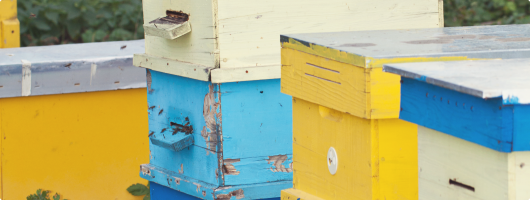Activities of the apiary
The individuals of the three classes have the same basic characteristics; however, they have specific morphological and anatomic differences, which are linked to their role in the life of the apiary. All the activities in an apiary are performed by the worker bees with an astonishing dissemination of work. Below we will analyze the activities of an apiary.

Breeding of an offspring
The breeding of an offspring is a task performed by the nanny bees, which are mainly young bees 5-13 days old. Nanny bees feed the offspring with honey, pollen and royal jelly and they ensure that the area of the offspring has a stable temperature of 34-35°C. To take care only one larva, more than 2,800 nannies work sequentially for approximately 10 hours.

Taking care of the queen
The queen bee is always escorted by a number of worker bees, the escort bees, which have as a mission to feed the queen, clean her and to circulate throughout the apiary the chemical substances or pheromones she excretes. All the chemical substances that the queen bee excretes are called “queen substance” and this defines her identity and her uniqueness.

Cleaning the beehive
The worker bees remove everything they deem foreign to the apiary, whether this is a useless material or pathogenic organism. Whatever they cannot remove they mummify it with propolis, which has microbicidal and antifungal properties and acts as the beehive’s detergent. The workers also coat the interior of the cell with an oily coating, which they collect from the pollen and is known as pollen balsam. With this coating it is believed that the interior of a cell is sterilized and they are prepared for the queen’s egg-laying.
It is a fact that the cleanliness of the beehive is of vital importance for the survival of the apiary. Suffice it to say that in an area smaller than a square cubic metre 40,000 bees gather and the air inside the beehive is just as clean as outside of it. Besides, bees never leave feces inside the beehive.

Building honeycombs
Honeycombs are made of wax, which is exclusively produced by the wax glands of the worker bees and initially is a transparent liquid which is instantly solidified. In order for the wax glands to be activated, high temperatures and an abundance of nectar, honey and pollen are required. Each honeycomb consists of numerous hexagonal compartments, the cells, which are divided into worker cells, drone cells and queen cells. In these cells the food is stored and the offspring is brought up.
In the worker cells the young worker bees are raised, in the drone cells the new drones are brought up and similarly in the queen cells the young queen bees are raised. The hexagonal shape of the cell is the most ergonomic for the building of honeycombs. The circular, octagonal or pentagonal cells leave space between them, while triangular and rectangular cells have a larger perimeter and hence require more wax for their construction. The hexagonal cell saves wax, takes advantage of space and provides stability and durability to the honeycomb. Each kilo of honeycomb can hold up to 22 kilos of honey (Thrasivoulou, 1998). The construction of honeycombs is done in parts, by groups of worker bees hanging from a fixed point like fringes. These parts grow as the work continues and they are finally united into one uniform piece.

Adjusting the temperature
Bees are active between 10 and 38°C. When the temperature is high, groups of worker bees positioned inside and outside of the beehive entrance, flap their wings and they direct an air current from the outside to the inside of the beehive and another air current in the opposite direction. At the same time, another group of worker bees carries water and places it in droplets at various points of the interior of the beehive.
With the ventilation, the droplets of water are evaporated and this causes the temperature to drop. When the temperature is low the workers form a ball cluster, a solid layer consisting of many bees densely positioned next to each other. The thickness of this layer changes depending on the temperature changes. Inside this tight layer, the mass of the rest of the bees is loose.
The bees move around, consume honey and with tiny contractures of their thoracic muscles produce the required temperature for survival.
Orientation flights
The worker bee, before assuming her collector’s duties, exits the beehive and performs a few flights, to imprint in her memory the shape, the colour, the position of the her habitat, as well as the typical signs of the surrounding area. These flights are carried out in groups.

Guarding the entrance
The beehive entrance is guarded by a small or a large number of worker bees, depending on the danger that the apiary faces. The intruder is confronted with the sting, a complex organ which consists of glands producing venom and pheromones, a bladder containing the venom and other organs.
When a worker bee stings a mammal the stinger is detached from her body, resulting in her death.
After the detachment of the stinger, and for approximately one minute, the bladder containing the venom contracts and channels all of the venom into the victim’s body. The sting cannot be easily removed from the victim’s body because it carries hooks, which serve for this exact reason. Meanwhile, alert pheromones, which are secreted from the sting’s glands, mark the intruder making him a moving target for the other worker bees.
The bee’s venom contains biogenic amines, enzymes, polypeptides, various amino acids and aromatic volatile substances. The reactions caused by this are allergic reactions. It should be underlined that bees use their sting as a defence weapon to defend their colony and their survival is based in this exact defensive system (Thrasivoulou, 1998). Suffice it to say that they have to protect something valuable, the honey, which they store during spring and summer in order to survive winter.